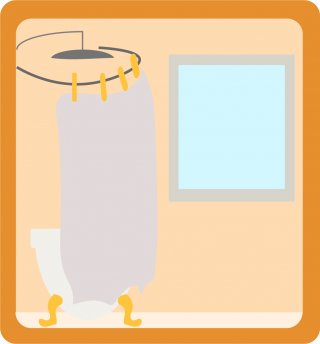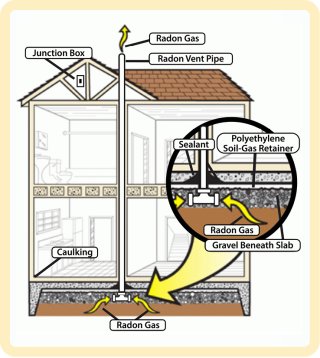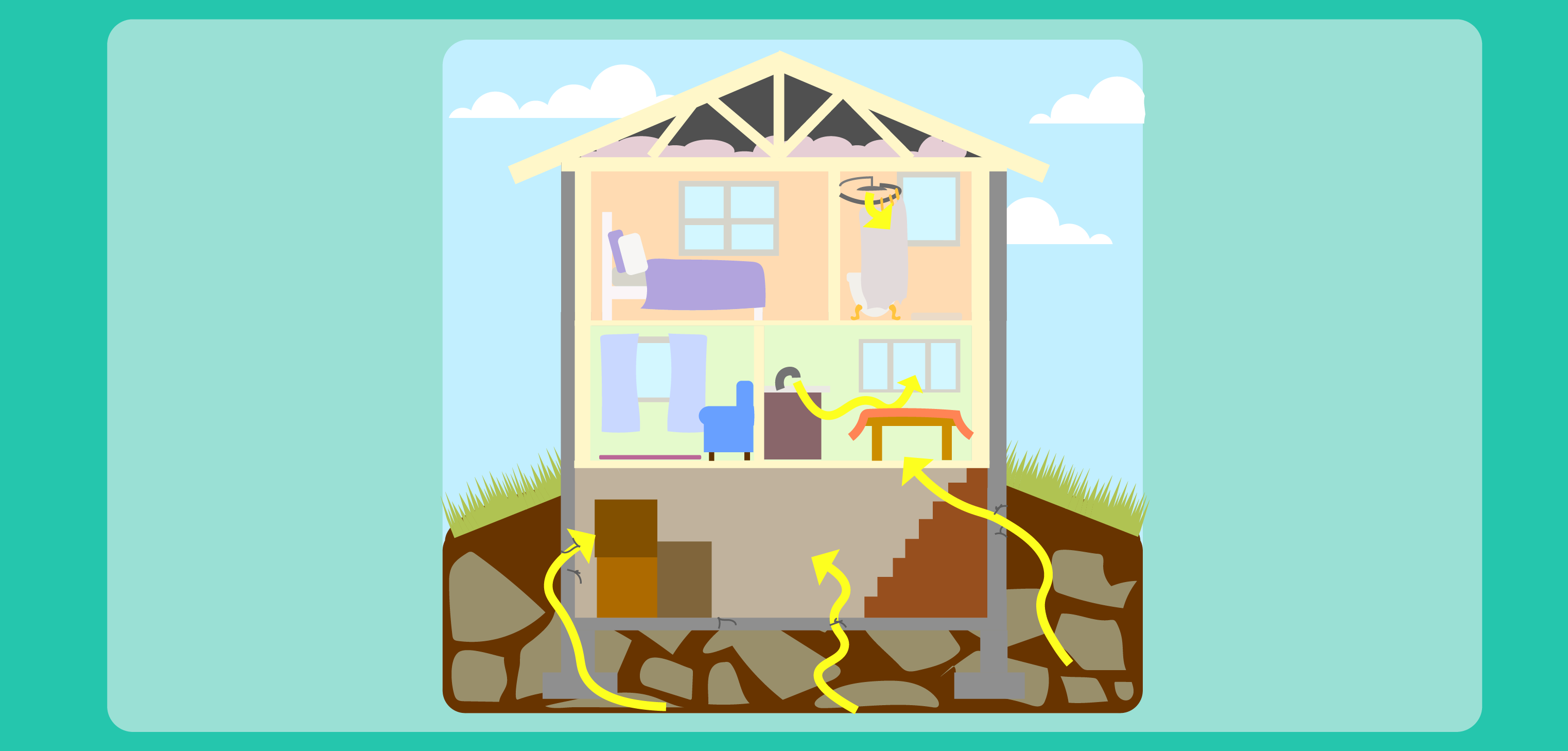RadTown Radon: Teacher Information
Radon is one of the most serious environmental health threats in the nation. Exposure to radon causes almost 21,000 deaths each year. This makes it the second leading cause of lung cancer for the nation as a whole. Nationally, one out of every fifteen U.S. homes has a problem with elevated radon levels. You cannot see radon, but it's not hard to find out if radon is a problem in your home. Radon can be detected with a simple test and elevated radon levels can be lowered with straightforward, proven methods. Testing is quick, easy and inexpensive.
- Background Information for Teachers
- How to Get Radon Test Kits
- Target Audience and Activity Topics
- Activity Times
- Next Generation Science Standards
- Common Core State Standards
- Additional Resources
Background Information for Teachers
You can't see radon. You can't smell it or taste it either, but it may be a problem in your home or school. Radon is a radioactive gas found in rock, soil and water. Radon is found all over the U.S. It can get into any type of building — homes, offices and schools — and results in a high indoor radon level. You and your family are most likely to get your greatest exposure at home, where you spend most of your time. The only way to know if your home or school has a radon problem is to test for it.
Breathing radon increases your risk of lung cancer. Radon is the second leading cause of lung cancer in the United States. More than 21,000 Americans die each year from radon-related lung cancer. Only smoking causes more lung cancer deaths. For more information about indoor air quality and the health risk of radon, visit the Health Risk of Radon webpage.
Radon in Homes or Buildings

Radon comes from the decay of uranium that is found in nearly all soils. It typically moves up through the ground to the air above and into your home through cracks and other holes in the foundation. Your home traps radon inside, where it can reach dangerous levels. Any home may have a radon problem. This means new and old homes, well-sealed and drafty homes, and homes with or without basements.
Radon can get into homes through:
- Construction joints
- Cracks and gaps in floors and walls
- Gaps around service pipes and through water supply lines
- Sometimes radon enters the home through well water.
Compared to radon entering the home through water, radon entering your home through the soil is usually a much larger risk. In a small number of homes, the building materials can give off radon, too.
Radon in Water
Radon in water supplies poses an inhalation risk and an ingestion risk. Research has shown that the risk of lung cancer from breathing radon in air is much larger than the risk of stomach cancer from swallowing water with radon in it. Most of your risk from radon in water comes from radon released into the air when water is used for showering and other household purposes.

Uranium Mining and Radon
Uranium mining releases radon from the ground into the atmosphere. Underground mines could pose a higher radon risk to both the public and workers. Mines and mining waste can release radioactive elements, including radon, and other pollutants to streams and other bodies of water. Federal and state agencies have set limits and drinking water standards, and continue to monitor these sites for public safety.
Uranium mine waste from operations that closed before the mid-1970s are of particular concern. Many abandoned uranium mines are located in the western U.S. and near Native American communities where uranium is generally found. In some cases, these mines were abandoned and the waste piled near the mine. Weathering can cause radioactive dust to be blown by the wind and seep into surface and groundwater. There are also cases of uranium mine waste being used for house construction, which creates significant radon and radiation hazards for the people living in those homes.
Living with Radon

Radon gas decays into radioactive particles that can get trapped in your lungs when you breathe. As they break down further, these particles release small bursts of energy. This can damage lung tissue and lead to lung cancer. However, not everyone exposed to elevated levels of radon will develop lung cancer. The amount of time between exposure and the onset of the disease may be many years.
Like other environmental pollutants, there is some uncertainty about radon health risks. However, we know more about radon risks than risks from most other cancer-causing substances, due to studies of cancer in humans (including underground miners).
Smoking combined with radon is an especially serious health risk. If people stop smoking and lower radon levels in their home, they can reduce their lung cancer risk significantly.
Radon Testing
Radon is measured in picocuries per liter of air (pCi/L), a measurement of radioactivity. In the United States, the average indoor radon level is about 1.3 pCi/L. The average outdoor level is about 0.4 pCi/L. The U.S. Surgeon General and the U.S. Environmental Protection Agency (EPA) recommend fixing homes with radon levels at or above 4 pCi/L. EPA also recommends that people consider fixing their homes for radon levels between 2 pCi/L and 4 pCi/L.
Testing your house for radon is easy. A simple test will tell you if your home has a high radon level. It’s as easy as opening a package and putting the test kit in the right place for several days. After sending the test kit back to the address in the package, the company will send your radon test results in about 2 weeks. Fixing a radon problem reduces the risk of lung cancer for you and your family.
Fixing and Avoiding Radon Problems
Buildings with high levels of radon have been found in every state. In fact, radon levels can vary greatly from building to building or home to home, even in close proximity. There are several proven methods to reduce radon in buildings, but the one primarily used is a vent pipe system and fan which pulls radon from beneath the house and vents it to the outside. This system, known as a soil suction radon reduction system, does not require major changes to the home or building. Sealing foundation cracks and other openings improves the system's functionality and makes the system more cost-effective. Similar systems can also be installed in houses with crawl spaces.

If radon in water is a problem, it can be fixed. Water supply treatments can be used to remove radon from the water before it enters your home, or at the tap. Treating water at the tap only treats a small portion of the water you use and is not effective in reducing the risk from breathing radon released into the air from all water used in the home.
Building new homes with simple and cost‐effective radon‐resistant features can reduce radon. Contact your builder or visit Building a New Home, Have You Considered Radon? for more information. Every home should be tested before, or soon after, you move in. Even homes built with radon‐resistant construction features should be tested. If high radon levels are found, it is easier and costs less to reduce radon levels in homes that are built radon‐resistant.
How to Get Radon Test Kits
- The National Radon Program Services at Kansas State University offers discounted test kits available to purchase online. You may complete the test kit order form electronically and print it out to mail or fax in. You may download a radon test kit coupon and mail it in.
- Many radon test kits can be found online or in home improvement stores. Follow the directions on the packaging for the proper placement of the device and where to send the device after the test to find out your radon level.
- Contact your state radon program for information on how to obtain a test kit from a radon measurement professional. Some states also offer free or discounted test kits to the public.
Target Audience and Activity Topics
The Radon activities introduce middle and high school students to radon’s physical properties and its health effects. The activities encourage students to test their homes and implement ways to reduce their exposure to radon.
Students will examine how radon moves through the ground and enters homes and buildings through cracks and gaps. The students will learn about solutions available to reduce elevated radon levels. Students will evaluate sample radon readings and determine if fixes need to be made to the home or building. Students are encouraged to test their homes using a short-term test kit and analyze their readings. These activities also examine radon’s decay chain, the half- life of radon and how these by-products can get trapped in the lungs and cause cancer.
NOTE: The term “radiation” used in these activities refers to ionizing radiation unless otherwise indicated.
Activity Times
All EPA Radiation Education Classroom Materials can be used individually or modified and combined to create multiple lessons. Activity options allow you to customize the activities to fit the time you have available (e.g., 1–2 class periods) and meet the needs and interests of your students.
The time needed to complete activities is between 45-60 minutes, not including optional activities or extensions.
Next Generation Science Standards
The concepts within these activity sets can be used to support the following science standards:
- ESS2. Earth’s Systems
- ESS3. Earth and Human Activity
- ETS1. Engineering Design
- PS1. Structure and Properties of Matter
Common Core State Standards (CCSS)
The concepts in the Vocabulary Activities align with the following:
- CCSS English Language Arts Standards for Literacy in History/Social Studies, Science, & Technical Subjects:
- CCSS.ELA-LITERACY.RST.6-12.2 Key Ideas and Details
- CCSS.ELA-LITERACY.RST.6-12.4 Craft and Structure
- CCSS.ELA-LITERACY.L.6-12.6 Vocabulary Acquisition and Use
The concepts in the Ground Up activity align with the following:
- CCSS English Language Arts Standards for Literacy in History/Social Studies, Science, & Technical Subjects
- CCSS.ELA-LITERACY.SL.6-12.2 Comprehension and Collaboration
- CCSS.ELA-LITERACY.WHST.6-12.1 Text Types and Purposes
- CCSS.ELA-LITERACY.WHST.6-12.9 Research to Build and Present Knowledge
The concepts in the Radon Vacuum activity align with the following:
- CCSS English Language Arts Standards for Literacy in History/Social Studies, Science, & Technical Subjects
- CCSS.ELA-LITERACY.SL.6-12.4 Presentation of Knowledge and Ideas
- CCSS.ELA-LITERACY.RST.6-12.7 Integration of Knowledge and Ideas
- CCSS.ELA-LITERACY.WHST.6-12.1 Text Types and Purpose
The concepts in the Indoor Radon Levels activity align with the following:
- CCSS English Language Arts Standards for Literacy in History/Social Studies, Science, & Technical Subjects
- CCSS.ELA-LITERACY.SL.6-12.2 Comprehension and Collaboration
- CCSS.ELA-LITERACY.SL.6-12.5 Presentation of Knowledge and Ideas
- CCSS.ELA-LITERACY.WHST.6-12.1 Text Types and Purposes
- CCSS Mathematics Standards
- CCSS.MATH.PRACTICE.MP1
- CCSS.MATH.PRACTICE.MP2
- CCSS.MATH.PRACTICE.MP5
The concepts in The Half-Life of Radon activity align with the following:
- CCSS English Language Arts Standards for Literacy in History/Social Studies, Science, & Technical Subjects
- CCSS.ELA-LITERACY.SL.6-12.1 Comprehension and Collaboration
- CCSS.ELA-LITERACY.SL.6-12.2 Comprehension and Collaboration
- CCSS.ELA-LITERACY.SL.6-12.5 Presentation of Knowledge and Ideas
- CCSS.ELA-LITERACY.RST.6-12.7 Integration of Knowledge and Ideas
- CCSS.ELA-LITERACY.WHST.6-12.1 Text Types and Purposes
- CCSS Mathematics Standards
- CCSS.MATH.PRACTICE.MP1

